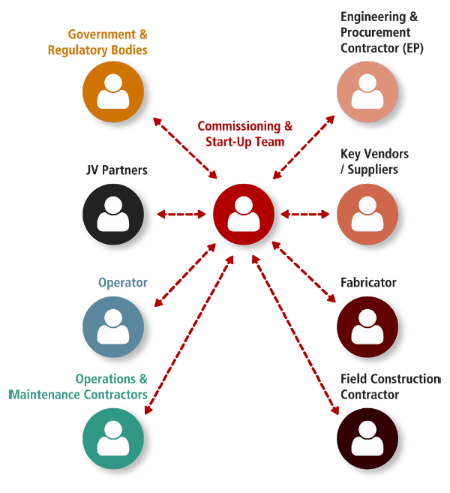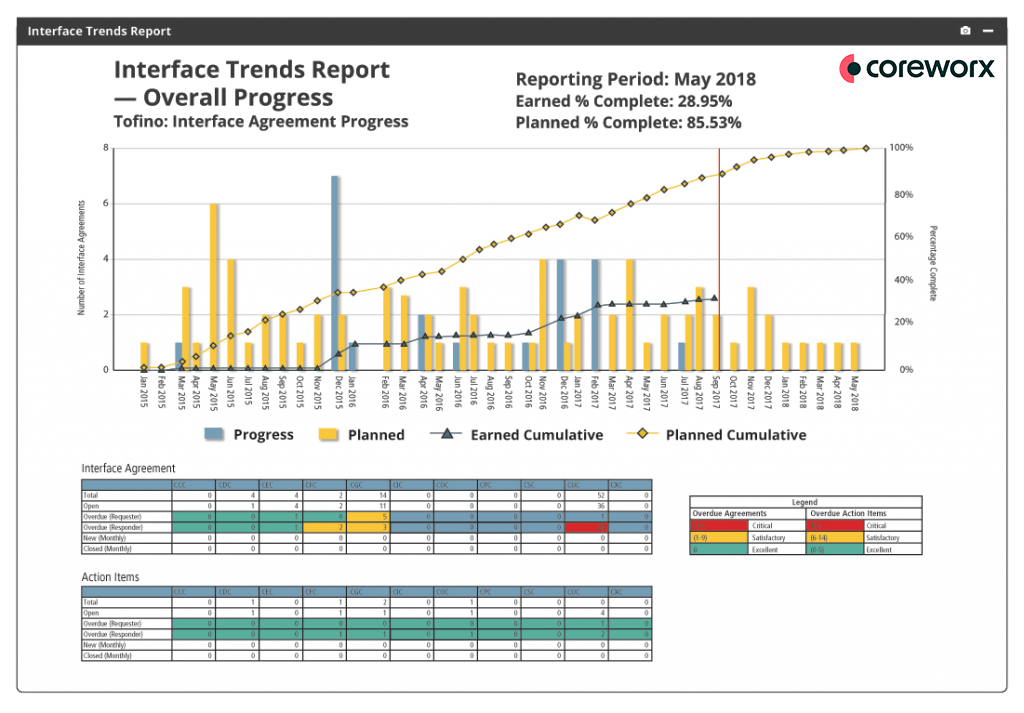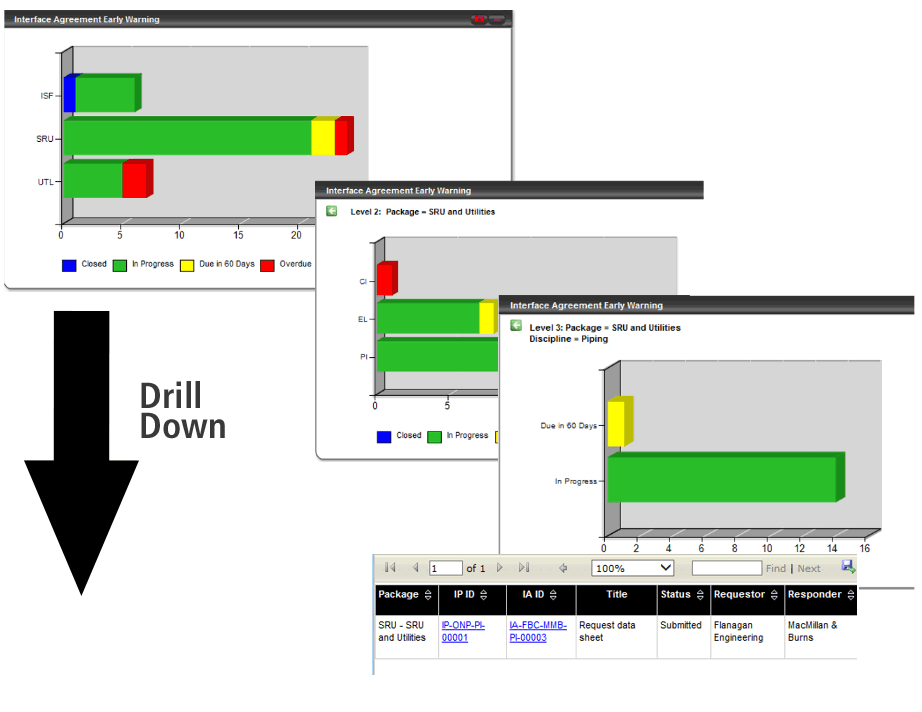
Commissioning and Interface Management
The goal of every major capital project is to achieve safe and successful commissioning. To reach this goal, commissioning plans and schedules are developed early and evolve as needed through the project’s various phases. These plans and schedules must focus on integrating the interactions between all project parties – engineers, constructors, suppliers, vendors, and operators – to ensure individual execution aligns with the overall project goals and the eventual commission & start-up sequence. The challenge of managing these interactions hinges on the reality that, typically, interactions are not captured in a single scope, purchase order, or integrated schedule, and fall outside into a gray area of ‘agreements’ that are facilitated by the commissioning team.

This article focuses on how an automated interface management solution can help commissioning teams better manage interactions (or interfaces) and minimize associated risks. In addition, learn how this central, automated solution can help commissioning teams ‘surface’ potential issues that enable them to stay ahead of problems – instead of fixing mistakes after they occur. With an automated interface management solution implemented, commissioning teams will significantly increase their probability for reaching successful commissioning.
Better Manage Interactions for Commissioning
As mentioned, commissioning begins with developing plans and schedules. As part of the commissioning plan, or as a separate interface management plan, the commissioning team must define the roles and responsibilities of each contributor as it pertains to each interaction or interface.
From a management perspective, the following must be clearly identified:
- All parties who interface with other parties (i.e. interfacing parties)
- Who’s responsible for what and when
- Who needs what from whom
- The need date for the defined deliverable – and ensure this date aligns with the overall schedule
With these definitions in place, all stakeholders will understand their responsibilities with regard to the execution plan, the schedule, and the deliverables required to meet the goal of a safe and successful start-up. In a perfect world, everyone executes smoothly and delivers on time. Of course, nothing in this world is perfect which is why it is important for commissioning teams to effectively track all communication and information related to project participant interactions. Tracking the thousands, if not tens of thousands, of information exchanges that must take place between all parties poses the greatest risk to reaching successful start-up.
With the size and scale of these projects, managing all interface communication and information manually is very risky. An automated interface management solution that is online, available to all project participants and includes predefined workflows which support direct and formalized communication will help ensure all parties get the information they need, when they need it. To achieve this, automation is key. An automated interface management system ensures roles and responsibilities are understood, defined and provide for automated notifications based on defined RACI matrices eliminating the potential for poor distribution of information.
Interface Management in the Real World
Interface management works to integrate interactions. For example, in a real-world project, key milestone dates are established, such as energizing of the primary and secondary electrical distribution system as defined by the project schedule. This is an interface point (IP). These are usually plant-wide systems that touch all areas of the plant. Energization takes place early to support a system’s completion schedule and begin early phase pre-commissioning and commissioning of long-lead systems. However, several participants need to interact and reach various agreements – interface agreements (IAs), along with the exchange and validation of supporting information for these milestones or IPs to be achieved. Contractors, engineers, equipment vendors, safety, and quality, must all clear their respective interface agreements. These could be pre-milestone, such as providing testing equipment, or post-milestone such as closing a specific punch item. Each agreement is a defined process with a defined deliverable. Other parties may not directly participate in a particular interface agreement, but they need to be kept aware of the status of these developments and be able to adjust their schedules as needed. One missed step, or one missed date, jeopardizes not just the date for energizing, but safety to all as well. This is where the interface management tool becomes mission critical.
Stop Managing by Exception
‘Management by exception’ is often the norm; only significant deviations or unsustainable trends that may jeopardize the execution plan and/or schedule are brought to the attention of management. In many cases, these deviations or trends can be tracked back to ineffective communication; a failed interaction or interface between two parties.
The key to proactive management is early detection. Reliance on ‘after-the-fact’ reporting will not get managers out in front of a problem early. Tracking interfaces throughout construction and commissioning using spreadsheets can be expensive and has the potential to further complicate the identification and resolution of a problem. An automated interface management system can provide oversight and visibility of all interfaces to all stakeholders. Automated systems offer real-time dashboards and reporting that allows management to quickly spot deviations or unsustainable trends that prevent efficient management.


Key Features for Commissioning
What are the key features an automated interface management tool should include that will feed this dashboard?
- Schedule Integration - Automatically tied to your scheduling tool so changes to the schedule can be captured in the interface management system.
- Portal for external parties/role based access: Maintaining confidentiality of information and documents as required.
- Single-page input: The party needing the information and the responding party use the same single input page. Less time spent recording information in multiple locations and fewer opportunities for data entry errors. All information is accessible and easily shared.
- Automated task notification: A workflow based on company policies and procedures that insures all who need to know are automatically notified throughout the entire process of the interface exchange.
- Early warning indicators: Reminders and early warning indicators of upcoming due dates and schedule slippages can improve project performance
- Document control: Ability to control the documents that are part of the communication exchange (e.g., test reports, P&IDs, specifications). Ideally, that same document feature would allow you to track and build your commissioning package.
- Repeatable Process:
- Request ->
- Receipt or request ->
- Acceptance ->
- Response ->
- Receipt of response ->
- Acceptance
- Auditable Process: Ability to identify all interactions within the system.
Summary: Commissioning Needs Interface Management
‘Poor communication leads to likely project failures’ is hardly a new revelation – we all know this. And with this knowledge, we are seeing a shift in how projects are managed overall – the big ‘digital transformation’ that’s moving us from old, disconnected ways of managing processes and information to a new, improved and completely connected digital way of managing projects, linking in all the best-practice processes and people. And this new method gives us a higher level of communication and far better insight into how a project is performing at any point in its life cycle. It’s where the world is going to improve project outcomes – and commissioning needs to be a part of this.
For the management of the commissioning process, the value of an interface management tool cannot be underestimated. While the CII 14% cost growth differential deals with the entire project, commissioning is the culmination of that process and will see great successes if it moves along the digital transformation journey and implements highly connected tools like automated interface management.



